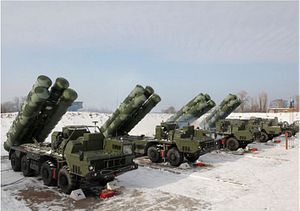The S-400 Triumf (NATO reporting name: SA-21 Growler) air defense system’s most advanced long-range missile, the 40N6 surface-to-air missile (SAM), was accepted into service with the Russian military earlier this month, TASS news agency reported on October 18.
“The 40N6 long-range missile has been accepted for service. All the necessary documents were signed in September, after which the Defense Ministry started the purchases of these missiles,”a Russian defense industry source was quoted as saying by TASS.
The 40N6 missile (the export variant of the missile is designated 40N6E) had reportedly been undergoing final operational evaluation and testing during the summer. According to another defense industry source, the 40N6 missile passed its final operational trials in July. The 40N6’s maximum engagement range is thought to be around 380 kilometers, while the missile’s maximum altitude for target interception is approximately 30 kilometers.
Designed and developed by Russian missile maker MKB Fakel, the missile will be serial-produced by the Moscow-based MMZ Avangard, the sole supplier of missiles for the S-400. “Overall, more than a thousand (…) 40N6 missiles are planned to be purchased under the state armament program through 2027 to provide newly formed and rearm existing S-400 regiments of the [Russian] Aerospace Force with them,” the defense industry source said.
The Russian military expects to operate a total of 56 S-400 battalions (28 regiments) by 2020. The last S-400 regiment was delivered to the Russian military in August. As I explained that month:
A S-400 regiment is divided up into two battalions (also called divisions in the Russian military), which in turn are split into two batteries. A battery can consist of up to 12 transporter erector launchers (TELs), although 4 to 8 TELs per unit are more common. In addition to the TELs, each battery includes a target acquisition and engagement (fire control) radar systems and a command post, as well as an additional fire control radar system.
The S-400 air defense system is reportedly capable of engaging up to 36 targets simultaneously. It can purportedly fire missiles at a rate 2.5 times faster than its predecessor, the S-300, and can engage stand-off jammer aircraft, Airborne Warning and Control System (AWACS) aircraft, and both ballistic and cruise missiles. As I explained previously:
In comparison to its predecessor, the S-300, the S-400 air defense system features an improved radar system and updated software; it can purportedly fire four new types of surface-to-air (SAM) missiles in addition to the S-300’s 48N6E, a vertical tube launched, solid fuel, single stage SAM with an estimated range of 150 kilometers (93 miles), and the improved 48N6E2 missile with a reported range of 195 kilometers (121 miles).
(…)
The S-400 is also armed with an improved variant of the 48N6E2 with an alleged range of 250 kilometers (160 miles). The air defense system can also fire two additional missiles, the 9M96E and 9M96E2 with respective ranges of 40 km (25 miles) and 120 km (75 miles). Improved S-300 air defense systems such as the S-300PMU-2 Favorite … can purportedly also fire the 9M96E and 9M96E2.
Russia first released details of the 40N6E, the export variant of the missile, during the 2018 Army Forum in August. India and Russia concluded a much anticipated $5.5 billion defense contract for five S-400 squadrons for the Indian Air Force (IAF) earlier this month. It is unclear whether the 40N6E is included in the final deal. The delivery of the first Indian S-400 squadron is expected in 2019.































